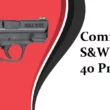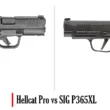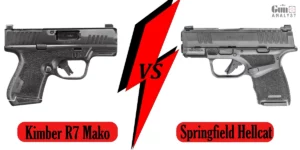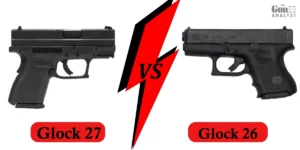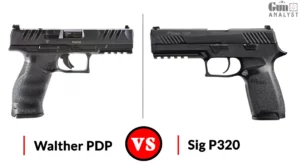The Beretta M9 and M9A1 are two of the world’s most famous pistols. Both are semi-automatic handguns intended for military and law enforcement use and are produced by the Italian firearms manufacturer Beretta.
However, there are some significant variations between beretta m9 vs m9a1 model that put them apart. This essay will go over these distinctions in depth.
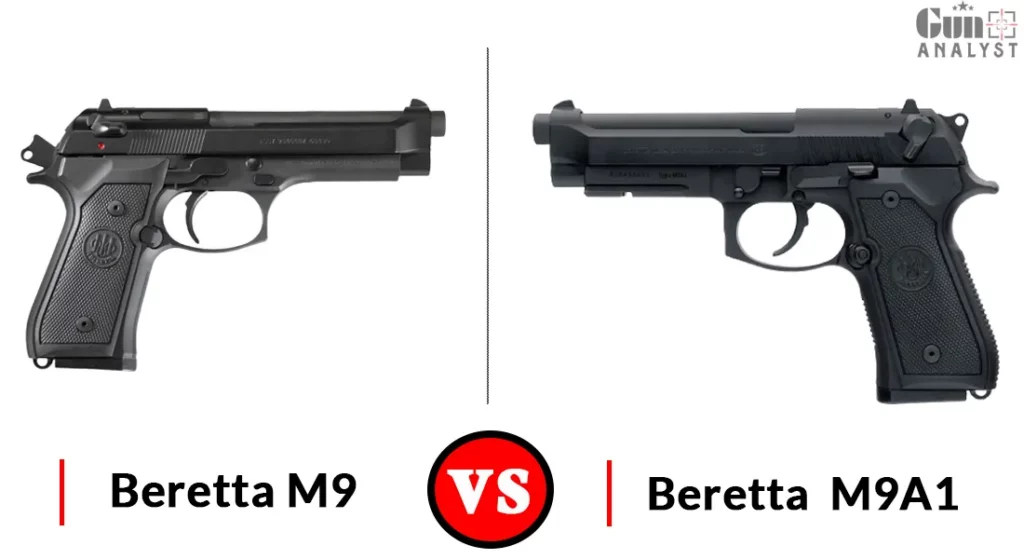
Beretta M9 vs M9A1: Quick Comparison Table
Here are some quick comparisons between these two handguns –
| Features | Beretta M9 | Beretta M9A1 |
| Cartridge | German 9*19mm Parabellum pistol cartridge | German 9*19mm Parabellum pistol cartridge |
| Sights | Fixed sights | 3-dot sights |
| Magazine | 15 round magazine | 17 round magazine |
| Weight | 33.3 oz. | 33.9 oz. |
| Length | 8.5 in | 8.5 in |
| Barrel Length | 4.9 in | 4.9 in |
| Width | 1.5 in | 1.5 in |
| Grip | Smooth plastic grip with pebbled texture | Aggressive grip with checkering |
| Safety | Thumb operated safety | Thumb operated safety |
| Height | 5.4 in | 5.4 in |
| Gun type | Pistol | Semi-automatic pistol |
| Design | Traditional rounded trigger guard | Squared-off trigger guard |
What Are the Differences Between Beretta M9 Vs M9a1? (Explained)
The Beretta M9 is a semi-automatic handgun that was chosen as the standard sidearm by the United States military in 1985. It was created by Italian firearms maker Beretta, and is based on the Beretta 92FS pistol.
But, the Beretta M9A1 is an updated variant of the Beretta M9 that includes several changes and enhancements. It debuted in 2006 as part of the Joint Combat Pistol initiative, which sought to supplant the M9 with a more modern sidearm.
Here are a few brief observations of these two handguns:
1. Design:
The Beretta M9 and M9A1 are both built on the design of the Beretta 92F from the 1970s. The M9 has a traditional rounded trigger guard, while the M9A1 has a squared-off trigger guard.
The M9A1 trigger guard’s squared-off constructions provides for a more comfortable and secure grasp, particularly for users with bigger hands or those wearing gloves. Furthermore, the M9A1’s squared-off trigger guard provides for easier access to the trigger, which can increase accuracy and speed.
The M9A1 also has a Picatinny rail integrated into the dust cover, allowing for the addition of different attachments such as lights and lasers. This function is not available on the M9, in comparison to the M9A1, this restricts its flexibility.
2. Grip:
The grip is another significant change between the M9 and M9A1. The M9 has a smooth, pebbled plastic grip. The texture adds traction and prevents the pistol from sliding in the palm. The M9 grip is comparatively slender and has a traditional smooth and rounded shape.
The M9A1, on the other hand, has a more aggressive grip with checkering and a bigger beavertail. The checkering adds a more aggressive texture to the handle, reducing the likelihood of the gun sliding or moving around in the hand.
The M9A1’s bigger beavertail protects the shooter’s hand from the slide during recoil, which is particularly essential during long shooting sessions. The grip of the M9A1 is also broader than the M9, which can be advantageous for people with larger palms or those who prefer a more robust grasp.
Overall, the M9A1 grip is intended to provide more control, ease, and longevity than the M9 grip.
3. Weight:
The M9A1 weighs significantly more than the M9. Unloaded, the M9 weighs 33.3 ounces (946 grams), while the M9A1 weighs 34.4 ounces (975 grams). This difference in weight is due to the larger grip and the addition of the Picatinny rail on the M9A1.
4. Sights:
The M9 has fixed sights with a front blade and a back notch that are dovetailed into the barrel. The front blade is thin and devoid of any dots or markings to assist in viewing. The back slot is also narrow and has two dots, one on each side of the gap, to provide contrast and assist in alignment.
In comparison, the M9A1 has three-dot sights, with a white dot on the front sight and two dots on either side of the notch on the back sight. In a variety of lighting situations, the three-dot sight method provides for quicker and more natural sighting.
The M9A1 also has a detachable front sight that can be simply replaced with a different sight if wanted. These functions are not available on the M9.
5. Magazine:
The ammunition capacity of the M9A1 is marginally greater than that of the M9. The M9 magazine holds 15 rounds, while the M9A1 magazine holds 17 rounds. The bigger clip enables for more rounds to be discharged before reloading, which is useful in battle.
The M9 was initially built with a magazine disconnect safeguard, which means it cannot be discharged unless a magazine is put into the grip. The M9A1, on the other hand, lacks a magazine disconnect safeguard, which means the gun can be discharged even if a magazine is not put into the grip.
6. Magazine Well:
The M9 has a comparatively small magazine well, which can make rapidly inserting and removing magazines more difficult. The M9A1, on the other hand, has a better magazine well design that is wider and more flared, making it simpler to enter and withdraw magazines swiftly and easily.
The M9A1’s broader and more flared magazine well can also help with dependability by enabling the magazine to sit more firmly in the grip. This can decrease the chance of failures caused by incorrect magazine placement.
7. Accessory Rail:
In comparison to the M9, the M9A1 has more flexibility and modification options thanks to the inclusion of an auxiliary rail, which allows the user to quickly connect lights, lasers, and other devices for better precision and situational awareness in low-light situations.
Because the M9 lacks an accessory rail, it cannot be readily equipped with devices that require a rail for attachment.
8. Durability:
The Beretta M9 and M9A1 are both extremely durable and dependable guns built to endure the rigors of military and law enforcement use. The M9A1 improves on the M9’s longevity by adding several features. The grip substance on the pistol is more robust and can provide even greater durability and resistance to wear and damage.
The M9A1 also has a strengthened frame and slide, which increases its durability. It is important to properly maintain and care for any firearm to ensure reliable function and long-term durability.
9. Range:
Beretta M9 and M9A1 both have the ability to discharge accurately at normal handgun combat distances of up to 25 yards or more. Both firearms have a 4.9-inch barrel, which gives them excellent accuracy and a reasonably lengthy sight radius when compared to other handguns.
The guns also feature fixed sights, which can provide good accuracy and reliability in a variety of conditions.
Safety Issues of Beretta M9 And Beretta M9A1:
Both the Beretta M9 and M9A1 handguns have a conventional thumb-operated safeguard on the left side of the frame above the grip. When the safety is activated, it stops the firing pin and prohibits the pistol from firing.
Both the M9 and M9A1 have a loaded chamber indicator, which enables the user to validate the existence of a round in the chamber visibly and tactilely.
The inclusion of a second safety on the M9A1 is a noteworthy distinction between the M9 and M9A1. This safeguard is situated on the rear of the grip and is activated by pushing in with the shooter’s palm web. This added safeguard protects against accidental firing by requiring an intended grasp to initiate the trigger.
Cost detail of Beretta M9 Vs M9a1
The price of the Beretta M9 and M9A1 pistols varies based on a variety of variables, including region, vendor, and any included accessories. Because of its extra functions and enhancements, the M9A1 is usually more expensive than the M9.
As of 2023, the Beretta M9 can be bought in the United States for around $600 to $800, based on the particular variant and condition. The Beretta M9A1, on the other hand, usually ranges in price from $700 to $900 or more, based on the type and features.
Frequently Asked Questions (FAQs)
What is the weight of the trigger pull on the Beretta M9 and M9A1?
The Beretta M9 and M9A1 trigger pull weight is around 10 pounds.
Do Beretta M9 and M9A1 have heavy recoil?
No, both guns have moderate recoil.
What is the origin of the Beretta M9?
After winning a competition to replace the outdated M1911 handgun, the US military initially used the Beretta M9 in 1985.
Can you customize the Beretta M9 and M9A1?
Yes, you can add custom sights, grips, and magazine.
What are some Beretta M9 and M9A1 alternatives?
Glock 17, Smith & Wesson M&P9, and Sig Sauer P226,.
Verdict
In conclusion, the Beretta M9 and M9A1 are two high-quality firearms that share many similarities but also have several differences.
The M9A1 offers enhancements such as a tactical rail, grip safety, and threaded barrel, while the M9 is a simpler, more traditional design. Ultimately, the choice between the two comes down to personal preference and intended use.
Related Posts:



